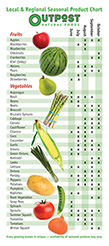The above information will be used only by Outpost Natural Foods for the express purpose of sending an e-newsletter. Outpost shopper information is never shared with other organizations or businesses.
Graze >>
Week 19 - The Secret Is In The Sponge

Week 19 - The Secret Is In The Sponge
A Year of InconvenienceFor one year, I'm making everything from scratch and forgoing convenience foods. Join me on my journey! By Pam Mehnert on August 31, 2010
So far on my journey I’ve baked nineteen loaves of bread (sandwich and/or English muffin), and my partner Lisa has baked three banana breads. Nineteen weeks – nineteen breads. You’re starting to get the picture. I will admit that baking bread has been a real chore and not the “hobby” I once enjoyed. A chore, that was, until two weeks ago when I discovered the magic that is “the sponge.”
When I refer to a sponge I’m not talking about a cartoon character named Bob, or the soggy square sitting by your kitchen sink. In baking, a sponge is made up of water, yeast, and flour – often with a bit of sugar to help the yeast to grow or activate. This mixture is often left to sit overnight and allowed to ferment and bubble into a mostly sticky mass that can then be used to create bread or rolls. Most of the artisanal breads with heavy crusts are made with a sponge.
The sponge is my new friend indeed - and really when it comes down to it – the sponge is the reason anyone can bake bread at home and get something that is not only delicious, but a great replacement for anything you might buy from the grocery store.
I found this recipe in a book I didn’t know I had on my cookbook shelf, “The Baker’s Dozen Cookbook.” I’ve adapted it only slightly from the original recipe of Peter Reinhart.
Don’t be afraid to bake this – it is absolutely delightful!
Multigrain Bread
To Make The Sponge:
1 ¼ cups water, at room temperature
1 tablespoon dry active yeast
1 tablespoon honey
3 cups (15 oz) bread flour
To Make The Dough:
¼ cup buttermilk
3 tablespoons honey
1 ½ teaspoons salt
1 cup (5 oz) of mixed grains (I used rolled oats, flax, wheat germ, and corn grits)
1 cup of whole-wheat flour
First step is to make the sponge. Combine the water, yeast and honey in the bowl of your mixer and let stand for about 5 minutes. The water will look slightly creamy when ready. Add the flour to the mixing bowl and mix for about one minute. (If you’re mixing by hand the book says you need about 100 strokes.) Cover the bowl with plastic wrap and let the mixture sit at room temperature for about 2 hours. This is when the magic happens because when you return to look at your sponge you’ll find a bubbly, yeasty, sticky mixture that smells like heaven!
Return the mixing bowl to the mixer stand and add the buttermilk, honey, salt and one cup of mixed grains. Make sure that is well combined before switching from the mixing paddle to the dough hook. Take your remaining cup of whole-wheat flour and add it very slowly with the mixer running on medium low speed, kneading the dough for about 10 minutes. If you’re kneading the dough by hand, knead in as much of the flour in as you need to make it smooth but just a bit tacky, for about 10 minutes.
Oil a large bowl (I use olive oil) and put the dough ball into the bowl, coating it on all sides. Cover tightly with plastic and let it rise for two hours. After two hours you want to punch the dough down to shape into a loaf. The first time I punched down dough it felt like undoing everything the yeast had worked so hard for over the past few hours, but then I learned that it’s all part of the magic.
Lightly oil a bread pan. To shape the dough into a loaf, press it flat into a rectangle about ½ inch thick. Bring the two long sides together and pinch the seam closed. Now fold in the two short sides so it’s loaf shape. Place the folded sides down in the pan, cover with a damp towel or greased plastic wrap, and let rise for another 1 ½ hours. It should be well above the pan when it’s ready for the oven.
Preheat your oven to 350° and set the rack to the middle of the oven. Before you put the bread in, spray the top with water and sprinkle on a little quick cooked oats. After the bread is in the oven for 10 minutes or so, spray the top with water again. This will give it a nice crust. Bake for 50-60 minutes. You’ll know the bread is done when it sounds hollow when tapped.
Here’s what Peter Reinhart has to say about this bread: “The challenge in making multigrain breads is providing enough gluten to enable the dough to rise. Since no other grains have as much gluten as wheat, adding other grains dilutes the overall gluten in the dough. This recipe uses a ratio that balances the unique flavors and textures of non-wheat grains but provides enough gluten to produce a light loaf with nice webbing in the crumb.”
Comments
Bloggers
Archived Columns
Tags
Archives
-
April 2024 (1)
March 2024 (1)
February 2024 (1)
December 2023 (1)
August 2023 (1)
March 2023 (1)
February 2023 (1)
November 2021 (1)
September 2021 (1)
November 2020 (1)
October 2020 (1)
July 2020 (1)
June 2020 (1)
May 2020 (1)
February 2020 (1)
January 2020 (1)
December 2019 (1)
November 2019 (1)
October 2019 (1)
August 2019 (2)
May 2019 (1)
March 2019 (2)
January 2019 (1)
December 2018 (1)
November 2018 (1)
October 2018 (2)
September 2018 (1)
February 2018 (1)
November 2017 (2)
October 2017 (1)
July 2017 (2)
March 2017 (1)
February 2017 (1)
January 2017 (1)
December 2016 (2)
November 2016 (1)
August 2016 (2)
July 2016 (2)
March 2016 (2)
February 2016 (2)
January 2016 (1)
December 2015 (1)
October 2015 (3)
August 2015 (1)
July 2015 (2)
June 2015 (1)
March 2015 (2)
February 2015 (2)
January 2015 (2)
December 2014 (2)
November 2014 (1)
October 2014 (3)
August 2014 (2)
July 2014 (1)
June 2014 (2)
May 2014 (2)
April 2014 (1)
March 2014 (2)
February 2014 (2)
January 2014 (2)
December 2013 (1)
November 2013 (2)
October 2013 (1)
July 2013 (2)
June 2013 (1)
May 2013 (2)
April 2013 (1)
March 2013 (2)
February 2013 (1)
January 2013 (2)
December 2012 (3)
November 2012 (1)
October 2012 (3)
September 2012 (2)
August 2012 (4)
July 2012 (4)
June 2012 (6)
May 2012 (3)
April 2012 (4)
March 2012 (6)
February 2012 (8)
January 2012 (3)
December 2011 (4)
October 2011 (4)
September 2011 (3)
August 2011 (5)
July 2011 (7)
June 2011 (1)
May 2011 (2)
April 2011 (7)
March 2011 (10)
February 2011 (12)
January 2011 (11)
December 2010 (19)
November 2010 (13)
October 2010 (22)
September 2010 (16)
August 2010 (24)
July 2010 (33)
June 2010 (5)
May 2010 (52)
April 2010 (37)
March 2010 (55)
February 2010 (44)
January 2010 (46)
December 2009 (40)
November 2009 (26)
October 2009 (37)
September 2009 (34)
August 2009 (24)
July 2009 (21)
June 2009 (29)
May 2009 (30)
April 2009 (33)
March 2009 (16)
February 2009 (2)
January 2009 (5)
November 2008 (1)
October 2008 (1)
September 2008 (2)
August 2008 (3)
July 2008 (2)
June 2008 (6)
May 2008 (2)
April 2008 (10)
March 2008 (5)
February 2008 (5)
January 2008 (12)
December 2007 (5)
October 2007 (3)
August 2007 (3)
July 2007 (1)
June 2007 (5)
May 2007 (4)
April 2007 (6)
March 2007 (3)
February 2007 (3)
January 2007 (4)
December 2006 (2)
October 2006 (2)
September 2006 (5)
August 2006 (8)
0 (1)










